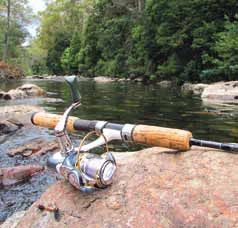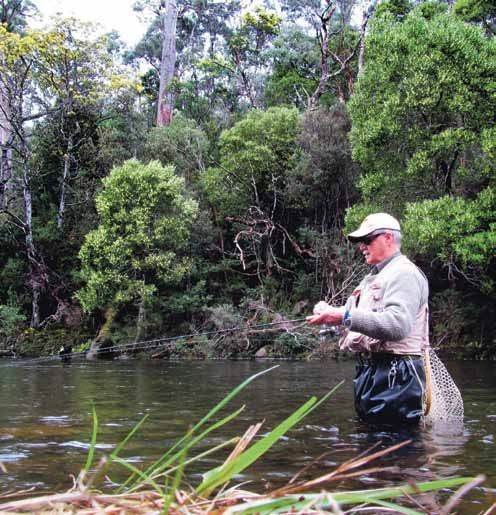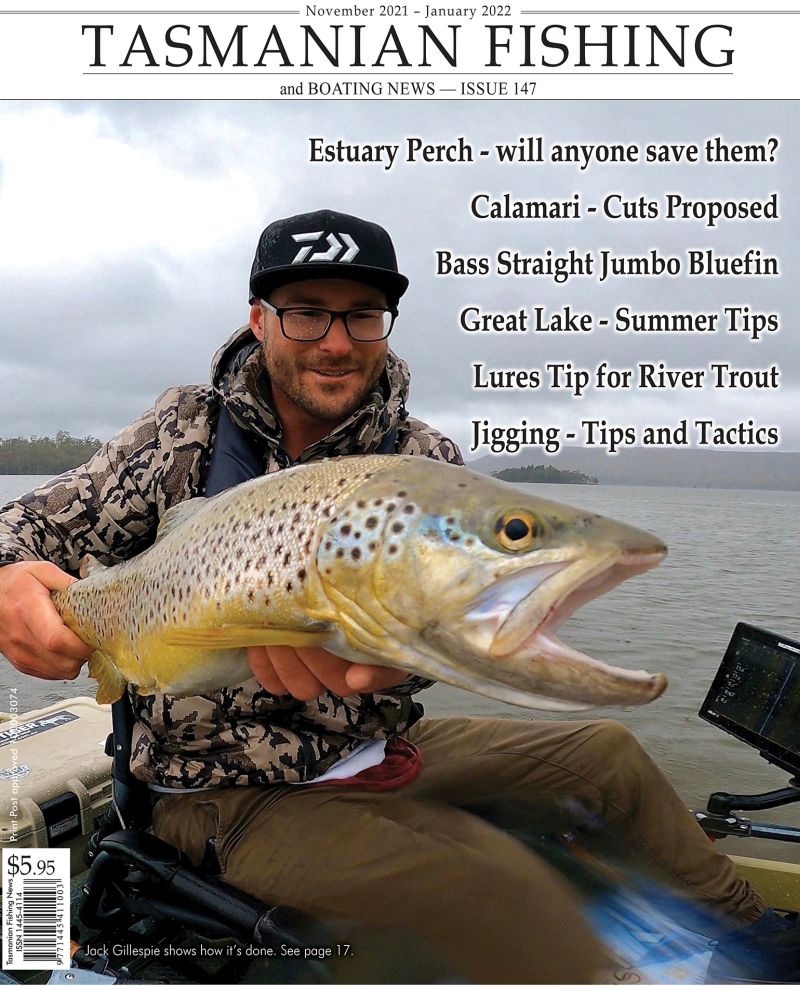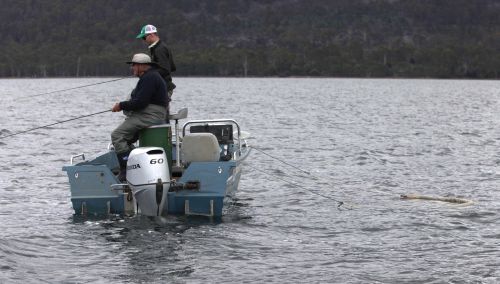 Presented from Issue 102, February 2013
Presented from Issue 102, February 2013
I began spinning for trout in 1965 in the Finnis River, Yundi, South. Australia, at the age of 19. Now at the age of 67 I am still loving it just as much, if not more than the first time. I now live at Sheffield, Tasmania and spin the rivers in the north, and in my opinion they are some of the best rivers in the State to fish. The Meander, Mersey, Leven, Iris, Vale, Emu and Flowerdale rivers are just a few of the many across the NorthWest to try.
In the south there are rivers like the Huon, Russell, Tyenna, Little Denison and the Weld plus many others. These, like many others are all good for spinning and wading.
To start, a good setup is essential. A light weight rod is a must, plus a good quality spinning reel and line and you are nearly there.
 |
| The author fishing one of his favourite streams |
The other piece of gear you need is a good pair of waders, a belt and a fishing vest. The rod I use is rated 1-5lb,with a Okuma 15a V-System reel filled with a good quality 4lb mono- line. When spinning you must also have an anti-kink set above the spinner, about 450mm, is ample, as this will stop any line twist that can occur when using mono-lines. Braid line is very popular now days but I prefer to keep with the nylon mono-line.
There are several other good brands of rods and reels available for you to choose from and also suit your budget. The most expensive equipment doesn’t mean that you will catch more fish, it is the way you go about it. So I suggest you shop around and you will find a setup that suits your pocket. I will give one bit of advice though, if you do intend fishing on a regular basis then it is wise to spend that little bit more than usual.
A suitable pair of waders will set you back anything from $100 to $500. I use a pair of Hornes waist waders, and this is where the belt comes in. Once on, put the belt around your waist and tighten, this will stop them from taking in water if and when you happen to take the plunge, and one day you will. I don’t know of too many fishermen that haven’t taken a dive. I have gone in several times.
The most important thing to remember when wading is not to take any silly risks. SAFETY must be your first priority as no fish is worth drowning over. Water depth can be deceiving. It is always deeper than it looks. DO NOT go out of your depth, it is not worth it.
Now with that out of the way your next items you need are a landing net and a fishing vest. Pick one with plenty of pockets for your lure boxes.
Metal blade spinners
Now it’s time for the range of lures. I am not a hard body or a soft plastics spin fisher, I am a metal blade spin fisher and this is one of the easiest methods of fishing when you first start spinning rivers. You can move on to the others once you’ve gained enough experience and are confident to try them if you wish to do so.
There are several different brands of metal blades to choose from like Blue Fox - Vibrax, Mepps and Celtas to name a few. I use the Mepps. They all have a good variety of colours and sizes. The Mepps I use are Black Fury, Comet and Aglia in the size 00, 0 and 1, as these are quite suitable for every river in Tassie.
The blade colours come in silver, copper, gold and black and they are light in weight starting at 1.5 gms, 2.5gms and 3.5gms.
Colour and style
Just because a spinner looks good doesn’t mean it’s going to catch fish. The vibrations of the spinner’s blade and its visual effects also play their part in triggering the trout’s attack. But which one do you choose? The following may help you.
- Silver: for morning light or when it is not strong (evening, overcast or shadowy places) and when the water is cold the metabolism of the trout really low that they need to be stimulated into attacking the spinner.
- Gold: work well most times of the day in most river systems.
- Black: work very well under strong sunlight, also shows up well in cloudy or flooded discoloured water.
- Copper: for tea-coloured waters and there are plenty of them in Tasmania. My first choice of spinner to use is the Black/ copper or gold colour, these have been my most productive spinners.
Practice casting
When you have yourself set up, it’s time to practice your casting! Go to a reserve and place a several objects around some to the left, ahead and to the right of you, then stay in one spot and practice casting at them. Vary the distance with the objects as too get the hang of different casting distances. Keep this up until you get within 150mm of them - the closer the better. Then move yourself to another spot and start again. Do this regularly until you feel comfortable with your distance and accuracy, because when you fish the rivers you will need it.
Once on the river you will find it quite different than the reserve - keeping your footing and balance for starters. Pick an open section of river that has a gentle flow and not over deep, then go out a few metres from the river bank and have a few casts to different areas around you.
Face yourself upstream and cast that direction and bring the spinner back downstream as this appears more natural — trout always face upstream waiting for food to drift downstream.
Once you get the hang of it, the confidence will follow, then you can start to venture out to the centre of the river.
Most rivers and streams in Tassie have rocky bottoms, can be quite hard to wade and are pretty rough on the body as well. Don’t rush into it, take one step at a time and make sure you have good footing before taking the next step.
This is when the experience of many years of river fishing comes into play. Given time, and if you go often, you too will gain the knowledge of wading a river. When you fish the same river over a period of time you get to know the sections of river that are easy and those that are not.
Move towards the middle and cast back towards the river bank and continue the casting until you have worked a full 180deg, to the opposite bank. By doing this then you have covered every section of water around you.
When the water depth is between the knees and the belt around your waist then that is the deepest you should go, any deeper can become a risk.
Trout are quite often caught in fast water stretches of rivers as well and I have caught the majority of my fish in these areas. Care must be taken with this type of fishing as you can come unstuck easily.
DO NOT go above knee depth if and when you fish these sections of river. Wait until you have had many more hours of wading a river before you enter this type of water.
The top and bottom ends of pools are always good spots to cast a spinner into as well, the trout will sit there waiting to pounce on anything that comes towards them.
Trout fishing can take as long as you want it too, especially when fishing rivers as there are so many stretches of river to fish. I am in the river on an average of four hours every time I go spinning. I am always wondering what is in the next section of water ahead of me. It’s like a disease and hard to get out of one’s system once it’s there. For the best results though, you do have to cover a good length of river. I figure no less than one kilometre otherwise you may as well put a worm on a hook and sit back and hope for the best.
Another way of gaining experience is to join an angling club. There are plenty of good fishermen in these clubs that will gladly offer you advice.
Also check out fishing sites on the web as there are plenty of reports and fishers willing to give advice. Goto www.tasfish.com
So here are a few pointers to remember that may help you once you are starting to have a spin in a river.
- DO NOT TAKE RISK BY GOING TOO DEEP this is one rule you must abide by as SAFETY is your first priority.
- Have someone with you on your first few trips and preferably an experienced river angler.
- Work the lure from one river bank to the other (180 deg) if fishing from the centre of the river.
- Work the spinner across the river by letting it drift with the flow and a slow retrieve with the occasional light twitch of the rod. This will often produce a hook up.
- Early morning (first light) or late afternoon fishing are usually the best times to be on the water.
- Don’t take more fish than you need for a feed, try to practice catch and release as much as possible. This way there will still be fish in the river for next time.
- Make sure you have a variety of spinners with you and more than just one of the same as you could lose a few from getting snag on a sunken log or a stray cast into a tree. It does happen!!
- Always work your way upstream as to approach the fish from behind. Good luck and get out there and have a go at spinning and wading some of Tasmania’s great rivers all over the State. You won’t regret it.
Check out what your local tackle shops have available to get you started into spinning one of Tasmania’s great trout rivers or streams.
Adrian Webb




